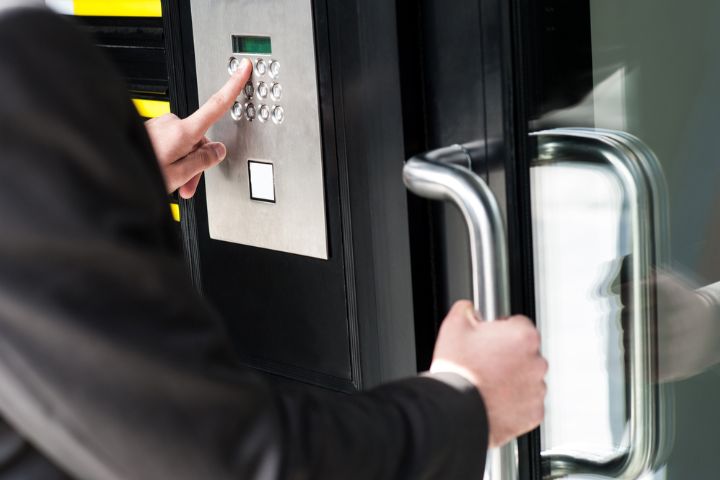Smart Lock: Technology And The Smart Opening Market

The market for smart locks is exploding; smart locks for the residential sector (homes, offices, professional studios, hotels, B & Bs, residences, etc.). All you need is a smartphone and an App to identify users, establish who and when can enter, command lock and unlock the lock (even remotely), and trace all events. No more keys in your pocket. The spread of mobile, smart homes, and, most recently, Covid-19 are driving the annual growth estimated at double figures between now and the end of the decade. The US is in a pool position; the Pacific regions are chasing, and Europe is struggling. All roses and flowers? We see.
In the beginning, it was a perforated plastic rectangle. Issued at the reception of luxury hotels, it allowed the guest to access their room after inserting it from top to bottom into the reader integrated into the door lock. A revolution, almost: for the first time in the centuries-old history of hospitality, it was no longer necessary to carry the key with you (often with a heavy bronze key ring), leave it, and collect it every time at the reception.
New technologies, old ways of use
The card and the lock have evolved over time. On the one hand, the magnetic strip has taken the place of the perforations; on the other hand, there has been a shift from local programming (stand-alone) to centralized management. Security and management have improved, but the methods of use have remained essentially the same for decades. A further step forward in safety and ease of use was finally recorded at the beginning of the new millennium with the spread of RFID (Radio Frequency Identification) technology: now, it is sufficient to bring the card (or transponder) close to the lock before entering.
For the avoidance of doubt
Already in the 1970s, there was talk of “smart locks,” but their application was limited to the hotel sector or a little more. In the following decades, this market has not only evolved from a technological point of view but has also conquered new spaces. Today on the market, there is an infinite choice of solutions able to satisfy every need. However, it is necessary to clarify the term smart lock. Any lock that can unlock a door without the use of the traditional metal key can be considered “smart.” In common parlance, however, by smart lock, we mean a “consumer product” intended for the home automation sector in the broadest sense of the term (homes, residences, hotels, B & Bs, shops, etc.).
The key points
From a technical point of view, a smart lock is distinguished by some key points: the automatic recognition method of users, the way it works and how it exchanges data with the outside world, and the mechanism used to open and close the door. The most common identification techniques are:
- The traditional PIN (personal secret code).
- The token (card, key ring, smartphone, etc.).
- The biometric fingerprint (especially digital ones).
Recognition, in short, follows the traditional access rule: what you know (code), what you have (device), and who you are (fingerprint). On the one hand, therefore, the user holds one or more credentials to be recognized; on the other hand, the lock incorporates a reader capable of reading the credentials themselves. In order to manage a numeric code, the lock provides a small keyboard on the front (increasingly in a touch panel version), a reader for the token, for fingerprints a biometric sensor. Some smart lock models integrate multiple recognition techniques to be used as an alternative to each other (such as for example, fingerprints or PIN) or in combination (multimodal). The most advanced and most secure technique (but also the most expensive) is based on the verification of fingerprints; the most popular is using your mobile phone with the App on board.
One App is enough
There are smart locks that operate in stand-alone mode (programmed one-off, work locally independently) and others capable of interacting with the outside world (exclusively wireless). In both cases, the device can manage at least a hundred different users. The most popular data transmission standards (protocols) are Bluetooth (in particular Low Energy), NFC (Near Field Communication), Wi-Fi, and Z-Wave. If the connection is local (for example, between lock and smartphone), the standards used are Bluetooth (a few meters away) and NFC (contact reading). If you want to interact remotely, you need an internet connection via Wi-Fi. Finally, Z-Wave is used for more complex and integrated applications in intelligent civil buildings.
Voice assistants and geofencing
The dedicated App allows you to control the opening and closing of the door from a mobile device, in your presence, or remotely. Some solutions allow connection with Amazon Alexa, Google Home, and Apple HomeKit in order to interact with Siri. The most modern keyless entry products (as this market is called in the jargon) also manage geofencing. Once the reference “fence” has been established, and the function activated on the smartphone, the door can unlock or lock automatically as soon as the user enters the specific area or leaves it.
A delicate point
The electromagnetic device integrated into the smart lock is necessary to open the door mechanically (after recognition) and close it again when the door is approached, depending on the physical structure of the frame, the degree of security required, and other factors. It shouldn’t differ much from that present in traditional mechanical locks (and therefore guarantee the same level of physical security), but this is not the case for all models.
Smart locks fit perfectly when applied to simple structures (interior doors in wood, aluminum, PVC, etc.); they struggle or are forced to give them up in other situations (such as special doors and gates, as well as vehicle gates, pedestrian gates, and similar). From a mechanical point of view, the smart lock takes place; therefore, the key-operated latch in the deadbolt models (similar to our most popular “push and open” models), lever handle, and padlocks. Finally, some smart locks integrate a proximity sensor that allows you to detect whether the door is closed (leaf close) or open, greatly improving the level of monitoring and safety.
pros and cons
Having a smart lock on a door means abandoning the use of the metal key (with the advantages that derive from it in the event of theft or loss of even a single copy), opening it as soon as you are on the threshold or approaching your mobile phone, knowing it status (open/closed), enable the access of occasional guests (even at a distance), have a detailed history of all events and even a discount in the insurance policy.
In the face of undoubted benefits, however, it is also necessary to consider the risks that may derive from it. Both the smart lock and the mobile device, in addition to not being fool-proof, can fail, lose the configuration, request updates, etc. The smart lock works via internal batteries; the consequences caused by a failure to replace it in good time are imaginable. When installing a smart lock, in short, unless it is equipped with a traditional metal key to be used in an emergency, you have to take into account the possibility of being locked out.
Furthermore, replacing the old lock with a smart type must not compromise physical resistance against actions by malicious people. The rooms inside a B&B or a residence are one thing; the other is the apartments in the suburbs where crime lurks. The scene of the little family that leaves the house every morning, pulling the door behind it, typical of American sitcoms, does not belong to us. Better two bolt turns (if not four). Finally, the consequences related to the violation of privacy and possible cyberattacks should be taken into account even if,
A bright future
Several international companies specializing in market research have probed and continue to plumb the demand and supply of smart locks globally and regionally. The results are unequivocal but far from unambiguous due to the product mix examined. Some companies include, for example, even professional wireless mechatronic devices (cylinders, half-cylinders, handles, etc.), while others do not consider them.
Regardless of the estimated market value, all research projects a double-digit annual growth rate (CAGR) for the next decade. According to one of these reports, the global smart lock business in 2020 would have been $ 1.38 billion, reaching 5.28 billion in 2028 with a CAGR of 18.2%. To make the lion’s share in this sector is the USA: the estimates speak of a share of 45% of the entire turnover, and this should be maintained for the years to come. The demand from the Asian continent is also considerable. On the other hand, forecasts for Europe are less rosy, despite the Old Continent producing the safest and most innovative products in this field.
The keys to success
The great success of smart locks in recent times, according to analysts, is due to a series of concomitant factors: the spread of mobile devices and apps for unconventional applications, the growth of the IoT (Internet of Things), home automation and Building automation(smart homes and buildings), both in terms of renovations and new buildings. Covid-19 would also be helping: especially in the common entrances, and it would be avoided to come into physical contact with some surfaces potentially carrying the virus (questionable thesis, unless it is a sliding door or motorized door). At the offer level, there is only the embarrassment of choice. The investments in R&D by manufacturing companies are huge. In fact, dozens of manufacturers operate on the market, some of which are historical brands in the mechanical lock sector and others of the new generation.
But how much is it?
Smart locks are high-end products in the locking device market. While the price magnitude of traditional mechanical locks is a few tens of euros, that of smart devices is a few hundred. There are four cost components to consider. First, the price of the actual product depends on performance and technical characteristics (biometric models or models equipped with a touch panel are more expensive). Then there is the (highly variable) cost of installation and commissioning.
Do it yourself is not recommended. Better to rely on an artisan with proven experience, even more if enabled by the product’s original manufacturer. The same technician can help choose the model that best suits the door type. Also, consider the possible need for other extra components, such as the repeater to communicate with Alexa or Google Assistant. Finally, some solutions provide for the provision of services via the Internet against the payment of an annual fee.
Also Read : Chat Room Reviews -10 Popular Free Chat Rooms


